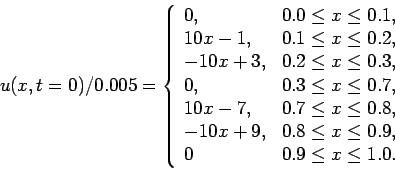


Next: Exercise 5.10: String with
Up: Waves on a string
Previous: Numerical solution: finite differences
Write a program to solve the wave equation using finite differences. Assume
that the string has a length  m, a linear density
m, a linear density  kg/m, and
tension
kg/m, and
tension  N.
N.
- Assume as initial conditions that the string is ``plucked'':
Plot the displacement  as a function of
as a function of  using a space step
using a space step
 m, and choosing the time step such that the solution is stable.
m, and choosing the time step such that the solution is stable.
- Explore the use of different steps
 and
and  and
determine at which values the solution becomes unstable. Does your
assessment agree with the condition (60)?
and
determine at which values the solution becomes unstable. Does your
assessment agree with the condition (60)?
- Change the initial conditions to
and compare results with the previous simulation.
- Consider a string plucked at two points:
Solve and observe wether the pulses move or oscillate up and down.
- Explore what happens when the string is places in a ``normal mode'',
for example:
Try other modes. See if the sum of two modes gives ``beating''.



Next: Exercise 5.10: String with
Up: Waves on a string
Previous: Numerical solution: finite differences
Adrian E. Feiguin
2004-06-01
![]() m, a linear density
m, a linear density ![]() kg/m, and
tension
kg/m, and
tension ![]() N.
N.


